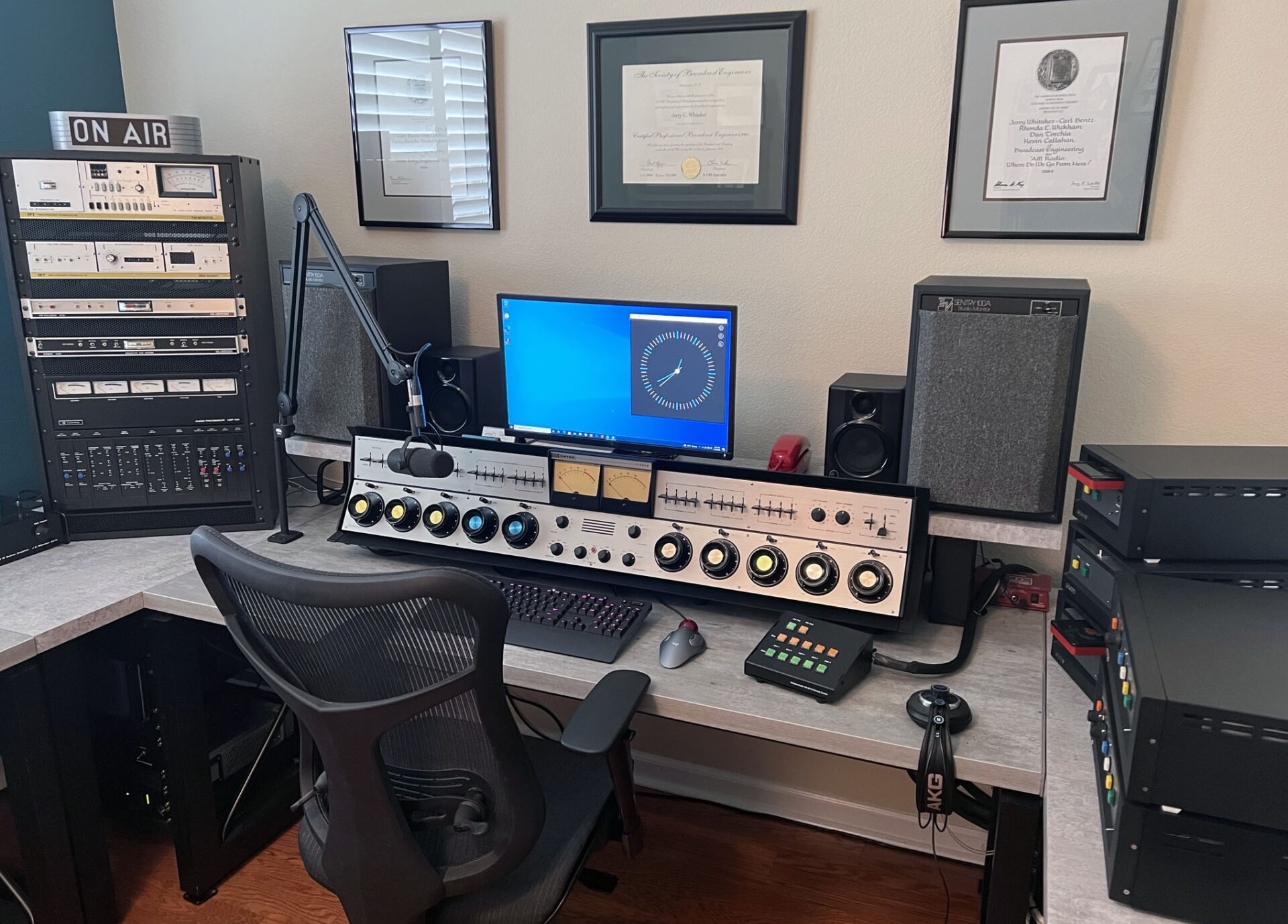
1970s Radio Studio Project
The 1970s were a great time for FM radio. As the dominant form of music entertainment of the time, working in FM was a great gig. This page brings it all back with a museum-quality studio straight from the '70s. This project evolved over time. But first some background.
Back in the day, I worked in radio in Northern California at an AM/FM station as Chief Engineer. It was a very good opportunity for me, since the owners at the time wanted the AM facility rebuilt and a new FM station put on the air. Even more important, they were willing to spend the money to do it right. It was a great experience. We had a very nice facility that served the community for many years.
Fast-forward four decades. In a chance visit to eBay one day I saw a Gates Executive Audio Console available for sale. We had one of those consoles at the station in the 70s. It came to pass that I purchased the console and rebuilt it. Then I went looking for other elements of the studio that I built back in the 70s. And that let me to a rather complete duplication of the FM studio I fondly remember from 40 years ago. And it all works!
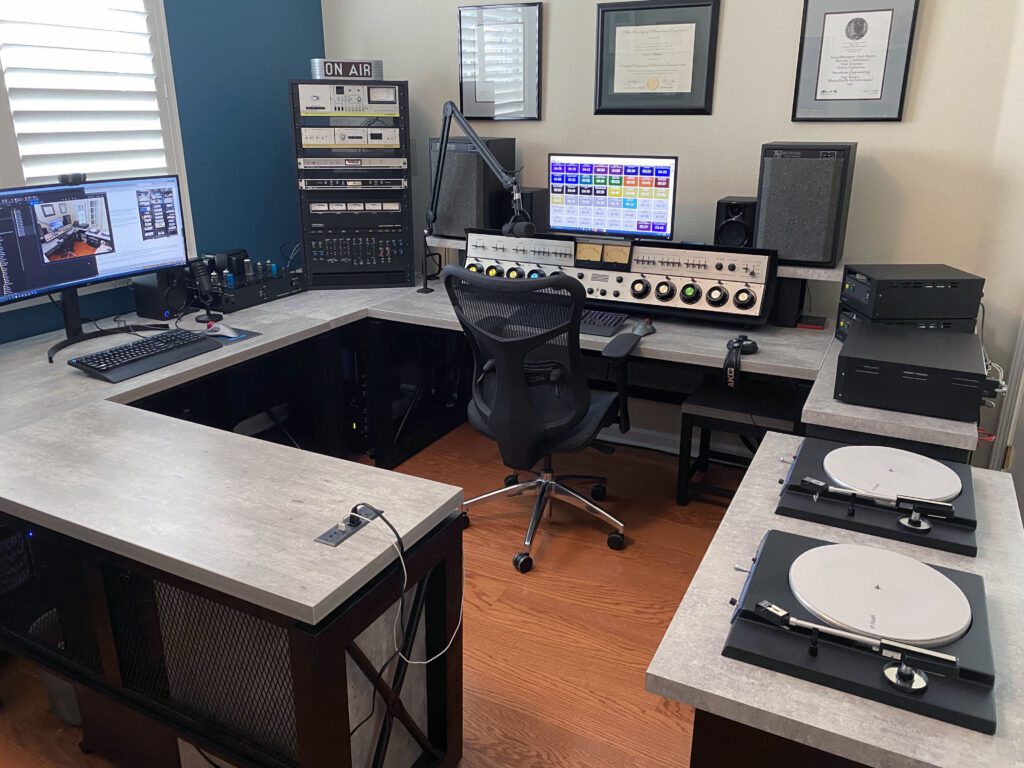
The center piece of the studio is a Gates Executive Audio Console. The studio in laid out in the usual U-shape, with a short return section at the rear. The return can function as an interview position.
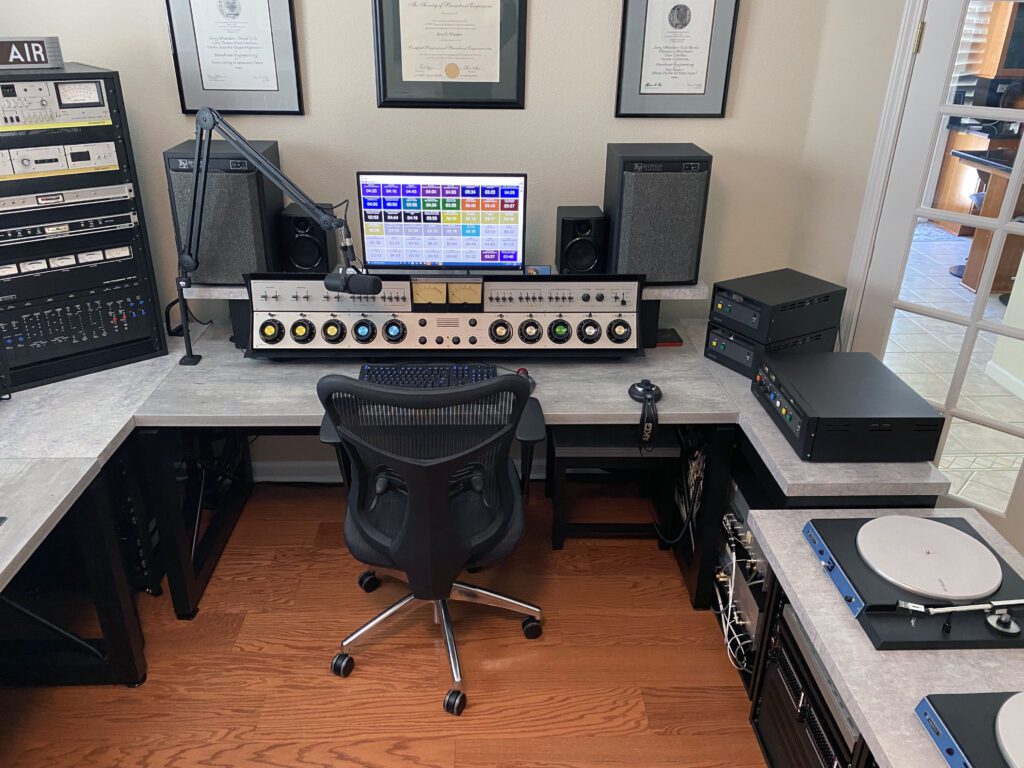
The studio occupies space in a working office. As such, space is somewhat limited and desk elements need to share functions. Very little attention has been paid to acoustics, since live recording is not currently done. Practical options exist for improving the acoustics, such as area carpets on the floor, movable baffles, and acoustic treatments of various types.

Input sources, in addition to a pair of Shure SM7B microphones and an SM58 microphone, include five Harris Criterion 90 cart machines. Two are record/play machines and three are play-only. There are two main turntables, both Harris CB1201 models, with Shure M232 tone arms and Shure M4407 cartridges. A third standby turntable (Hitachi HT-R10) is also available. Two reel-to-reel tape decks are included, an Ampex AG-440 professional machine and an Ampex 1455 consumer product.
A remote control box is provided for the cart machines and the Ampex AG-440. The unit features Start and Stop functions and illuminated pushbuttons that mirror the status of the controlled devices.
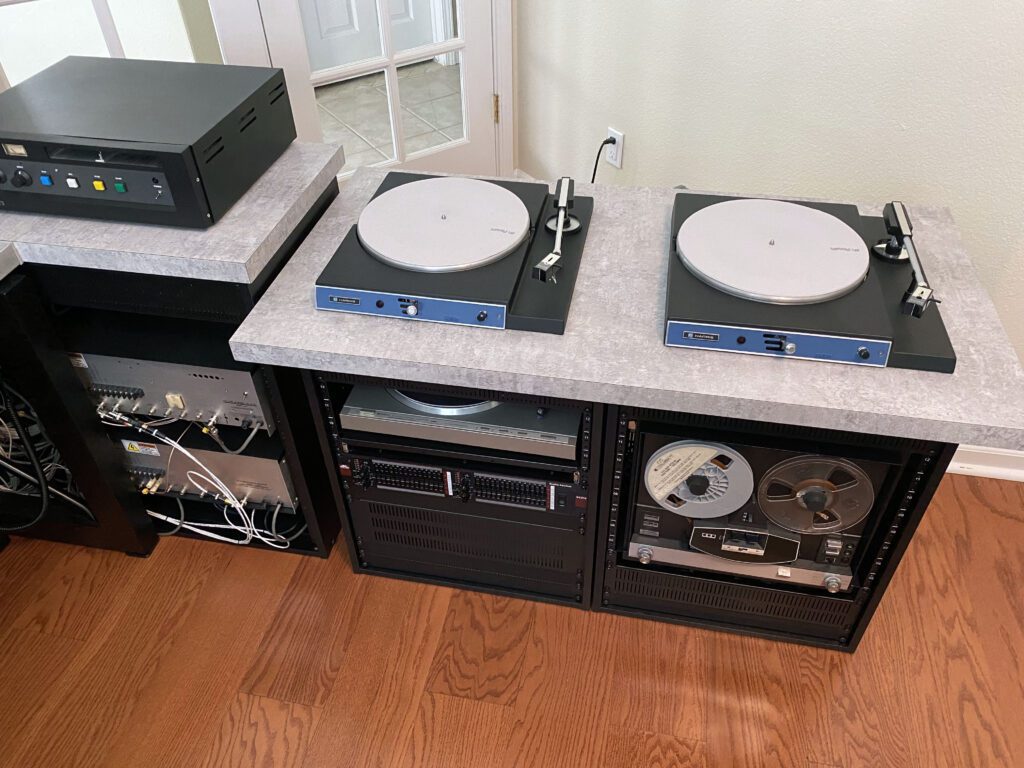
The turntables are in excellent condition. The Shure tone arms and cartridges are new-old-stock (NOS). A new felt pad is used on each platter to facilitate slip-cueing.
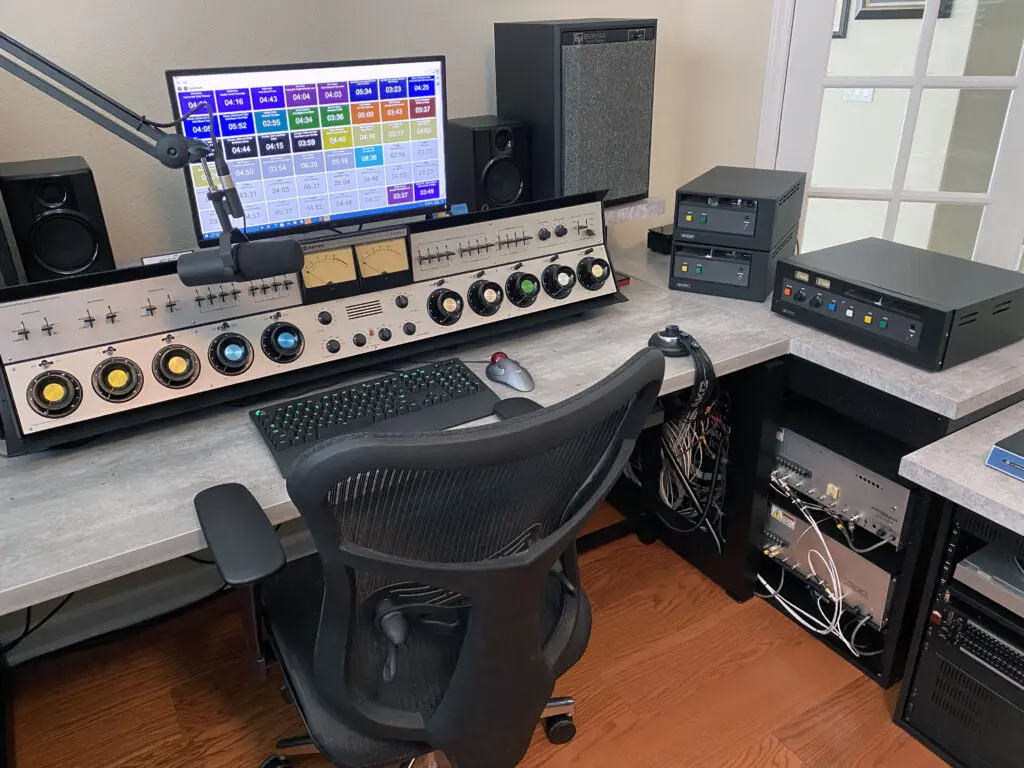
All input sources are grouped on the right side of the console, which is helpful for right-handed operators. (Regrettably, no so much for left-handed operators...)
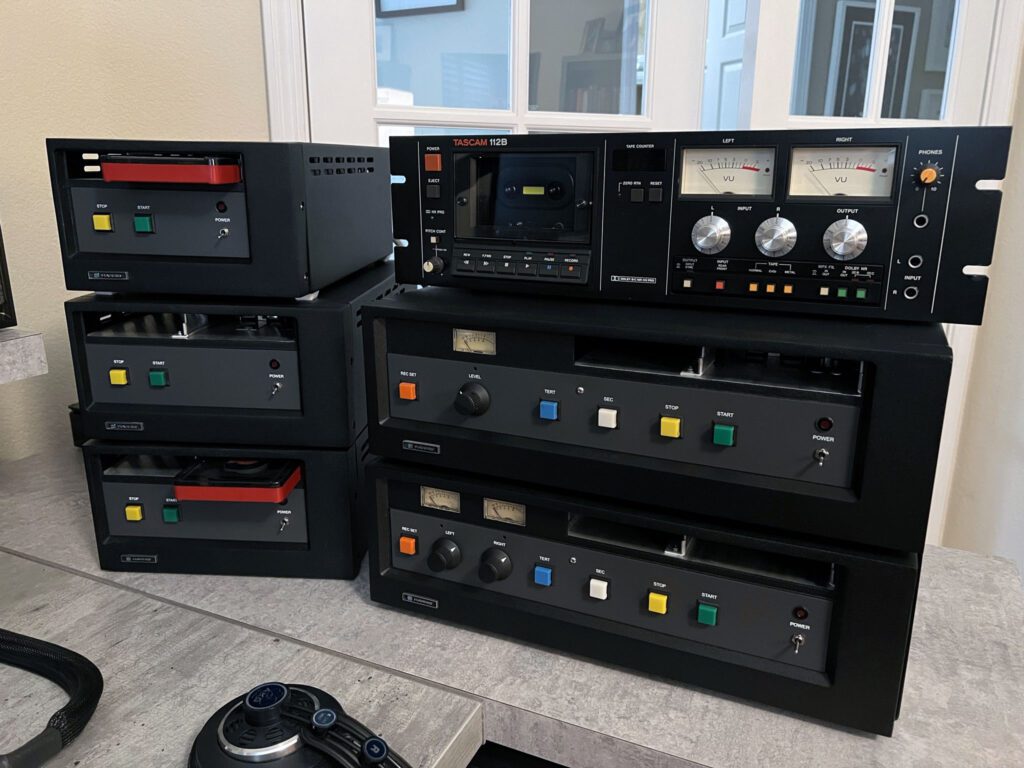
Since the original studio photos were taken, several additional pieces of equipment have been acquired, refurbished, and installed. These include two more Harris Criterion 90 cart machines and a Tascam 112B cassette deck (as shown above).
Cart machines, of course, need cartridges. After some purchases on eBay, a full rack of NOS and used carts was acquired. All the cartridges needed servicing because the head pads had lost their resilience (after all these years). Fortunately, new replacement pads were found thanks to a web search. 8 Track Avenue offers new cartridge pads for a number of machine types. It was a great find.
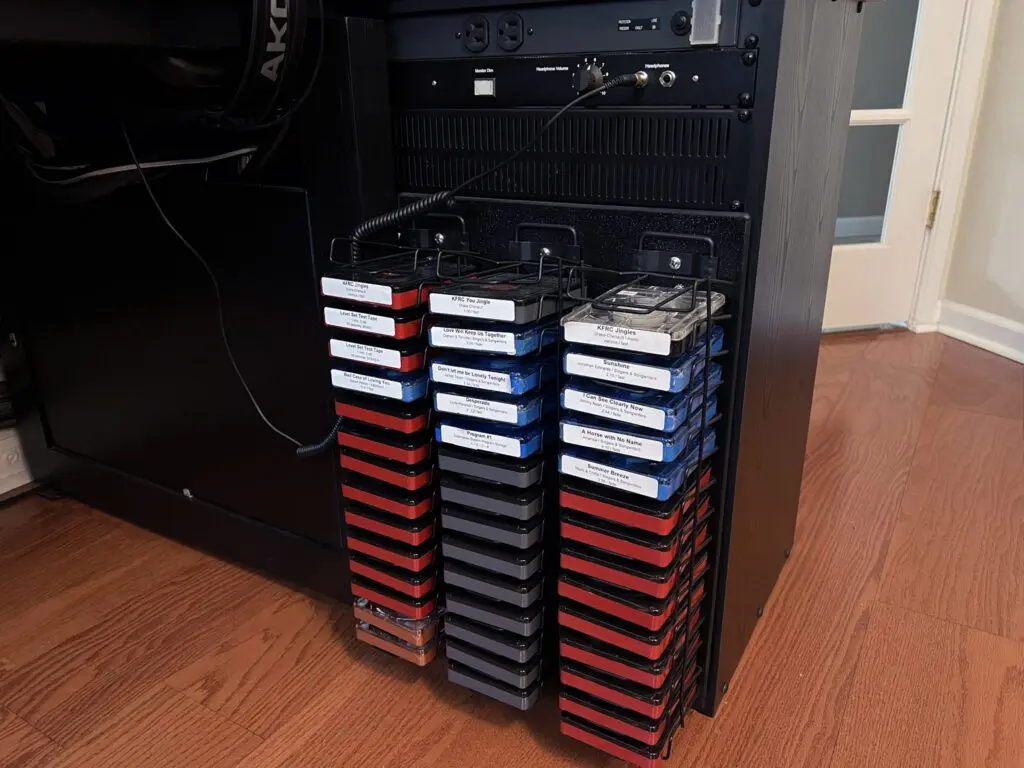
The third turntable in the studio was also upgraded to a Technics SL-1200MK3D. This turntable is intended for long-duration plays, whereas the two Harris CB1201 turntables are used for playing individual selections.
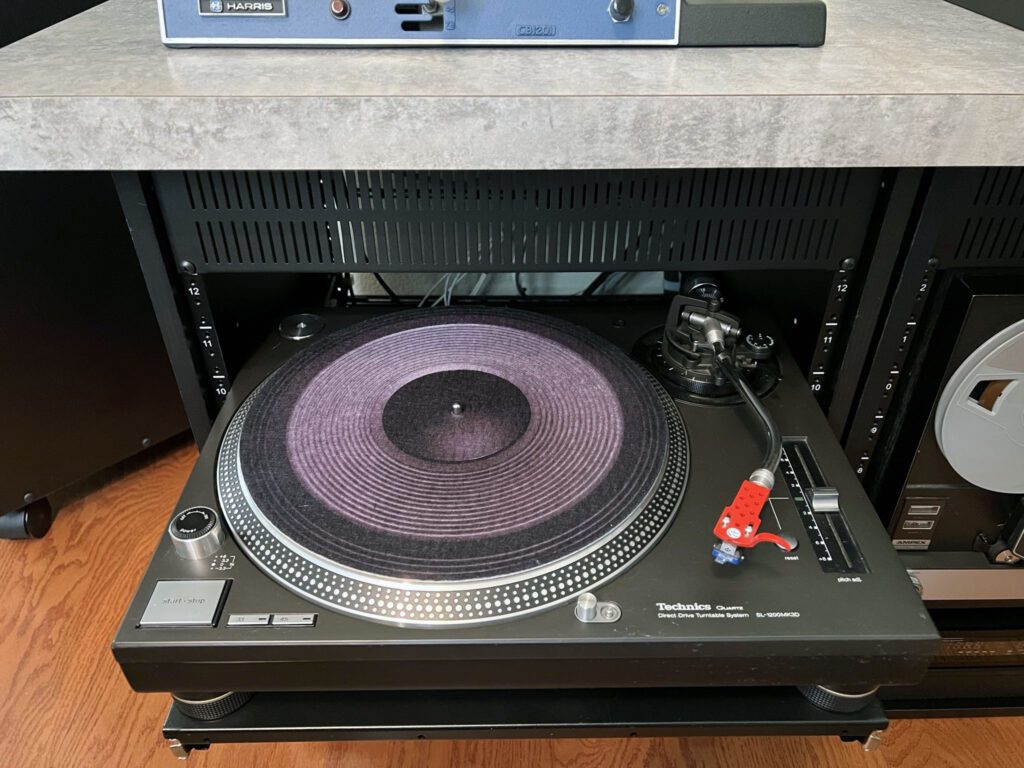
The turntable is on a slide-out rack for easy access.
A large collection of vinyl records is stored nearby. Thanks to the resurgence of vinyl, the collection includes a wide variety of genres, from classic rock to new pop releases.
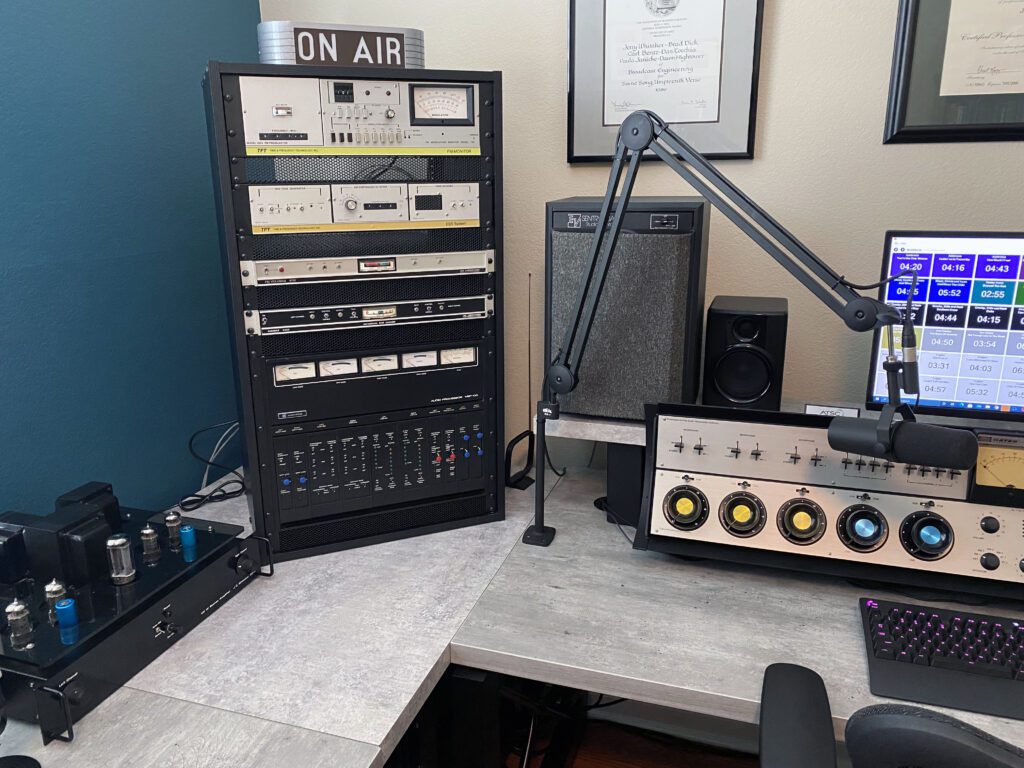
A compact rack houses all of the audio processing gear, which includes a Harris MSP100 tri-band audio processor, CBS Audimax 4400 gain controller, and CBS Volumax 4100 limiter. A TFT 760 Emergency Broadcast System (EBS) generator/decoder is also present. The top unit, a TFT 763 modulation monitor, provides confidence readings for the operator. A 40 W vacuum tube amplifier (on the left) is used to drive the two Electro-Voice Sentry 100A monitor speakers.
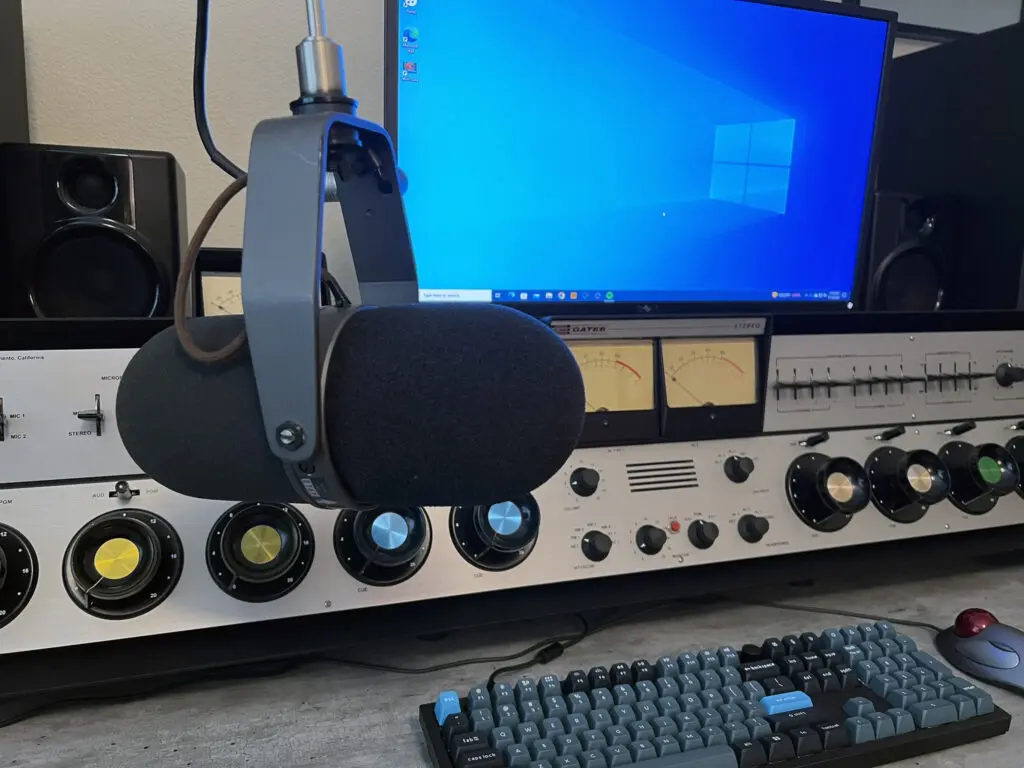
A recent addition is the Shure SM5B microphone shown above. This classic mic was used in my original 1970s studio, so I was very pleased to find one on eBay in good condition. The challenge with this type of microphone is finding new front and rear foam covers. Fortunately, new remanufactured end pieces are available from a couple of sellers on eBay.
The mic sounds great and fits perfectly with the rest of the classic gear in the studio.
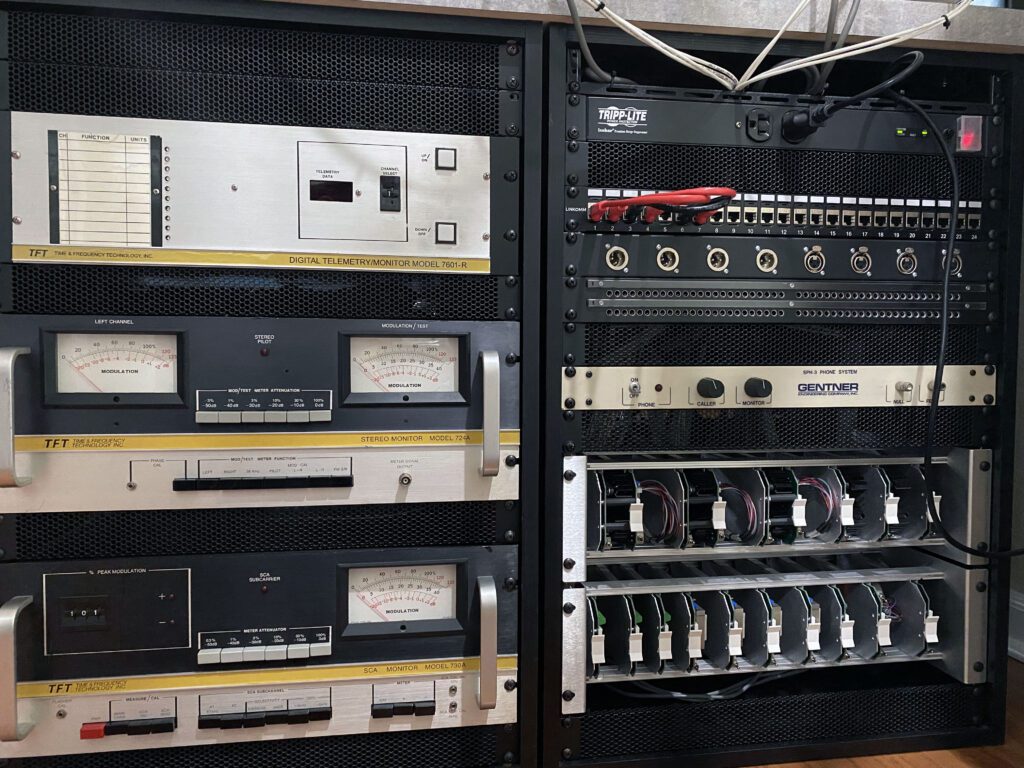
Twin racks are included for monitoring and terminal functions. On the right side of the photo, TT-type, RG-45-type, and XLR patch pays are provided. A Gentner SPH-3 phone patch can be seen below the patch bays. The top card frame houses program distribution amplifiers and the headphone amplifier. The bottom card frame houses input conditioning boards, a tone generator, and "cue/dim" controller. The "cue/dim" controller, when enabled, automatically decreases the volume of the monitor speakers when program sources are being cued. On the left side (from top to bottom) are a TFT 7601 transmitter remote control, TFT 724 stereo monitor, and TFT 730 SCA monitor.
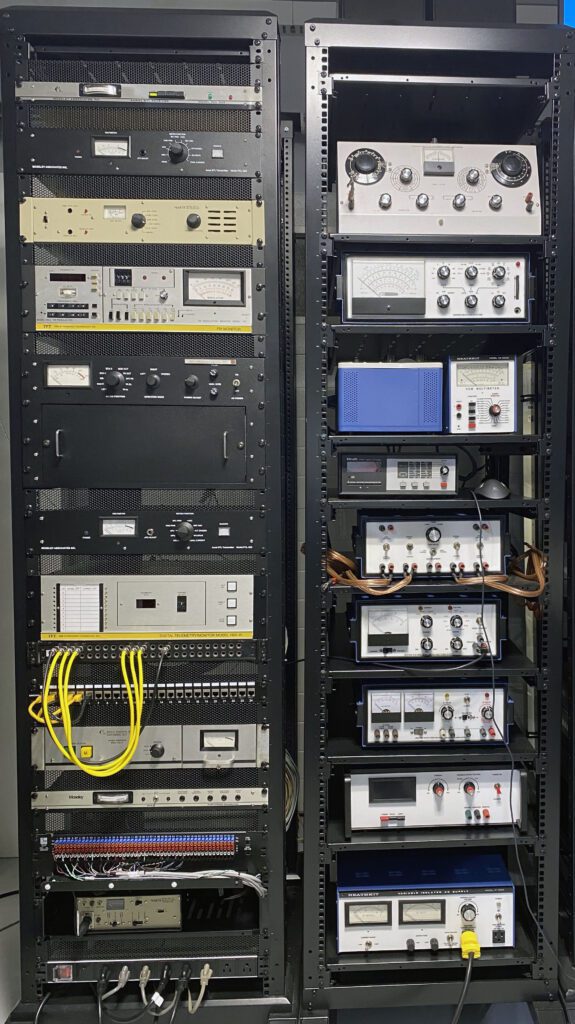
The transmission gear is housed separately in a 7-ft rack. The transmission rack is fed through Cat-5e wiring from the studio to the shop, which also serves as a transmission point.
It can be seen that most of the test equipment in the shop is of 70s vintage. All of the Heathkit gear shown has been returned to like-new condition. More on that can be found in the Heathkit IM 5248 Restoration Project and Heathkit Refurbishment Gallery blogs.
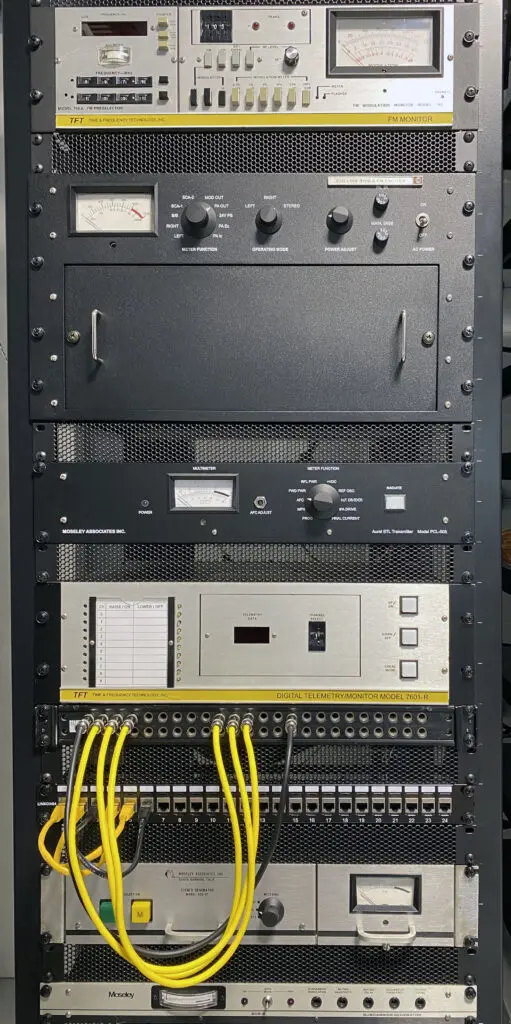
A Collins 310Z-2 FM exciter can be seen above. The exciter includes a 786V-1 stereo generator card. A second TFT modulation monitor is included in the rack, along with STL and RPU gear. Patch bays allow for reconfiguring the equipment as needed. The TFT 7601 is connected to the controller in the studio and can be used to energize or de-energize the exciter, effectively serving as the transmitter on/off control.
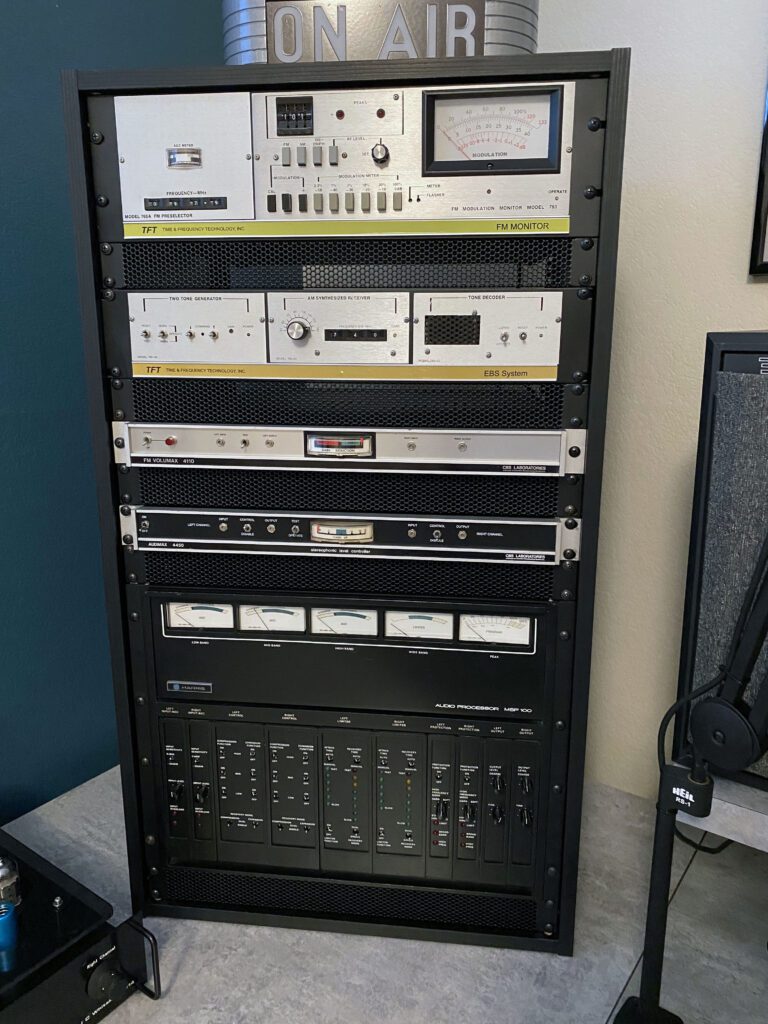
The full compliment of studio gear is as follows:
- Gates Executive Audio Console
- Shure SM5B microphone connected to Channel 1 (operator position)
- Shure SM7B microphone connected to Channel 2 (guest position)
- Shure SM7B microphone connected to Channel 3 (guest position)
- Two Harris CB1201 turntables with Shure M232 tone arms and Shure M4407 cartridges
- Technics SL1200MK3D turntable
- Harris Criterion 90 cart machines; three playback, two record/playback
- Tascam 112B cassette deck
- Ampex AG-440 reel-to-reel audio recorder
- Ampex 1455 reel-to-reel audio recorder
- WhitakerAudio WA-6012 Remote control box for the cart machines and AG-440, with illuminated status indicators
- Gentner SPH-3 hybrid phone patch
- Digital audio workstation with Digigram VX222-V2 sound card (the sound card is in a dedicated server; it links the 1970s hardware with current ways of accessing audio programming)
- AudioSource AM/FM tuner
- WhitakerAudio 40 W Stereo Power Amplifier
- Electro-Voice Sentry 100A studio monitor speakers
- M-Audio powered speakers for external cue monitoring
- WhitakerAudio utility card frame housing Left, Right, and Audition distribution amplifiers, headphone amplifier, test tone generator, "cue/dim" controller, level-matching preamplifiers, and associated interface gear
- AKG K240 headphones
- Harris MSP100 audio processor (for the stereo program chain) and a second (spare) MSP100
- CBS Audimax 4400 level controller (for the SCA channel or stereo program backup)
- CBS Volumax 4110 peak limiter (for the SCA channel or stereo program backup)
- Audio Logic SC215 dual-channel equalizer
- Audio Accessories 96 point Type TT patchbay, with custom interface panel for peripheral equipment
- Four Samson S-MAX MCD2 Pro 2-Channel Passive PC Direct Box, used for interfacing consumer equipment with the Executive audio console
- LINKCOMM 24-bay shielded RJ45 patch panel for telco interface
- XLR patch panel for mic-level sources
- TFT 760 EBS monitor/generator
- TFT 763 FM modulation monitor with TFT 765A FM preselector
- TFT 724 stereo modulation monitor
- TFT 730A SCA modulation monitor
- TFT 7601-C transmitter remote control
- On-Air warning light, which activates when the microphone channels are open
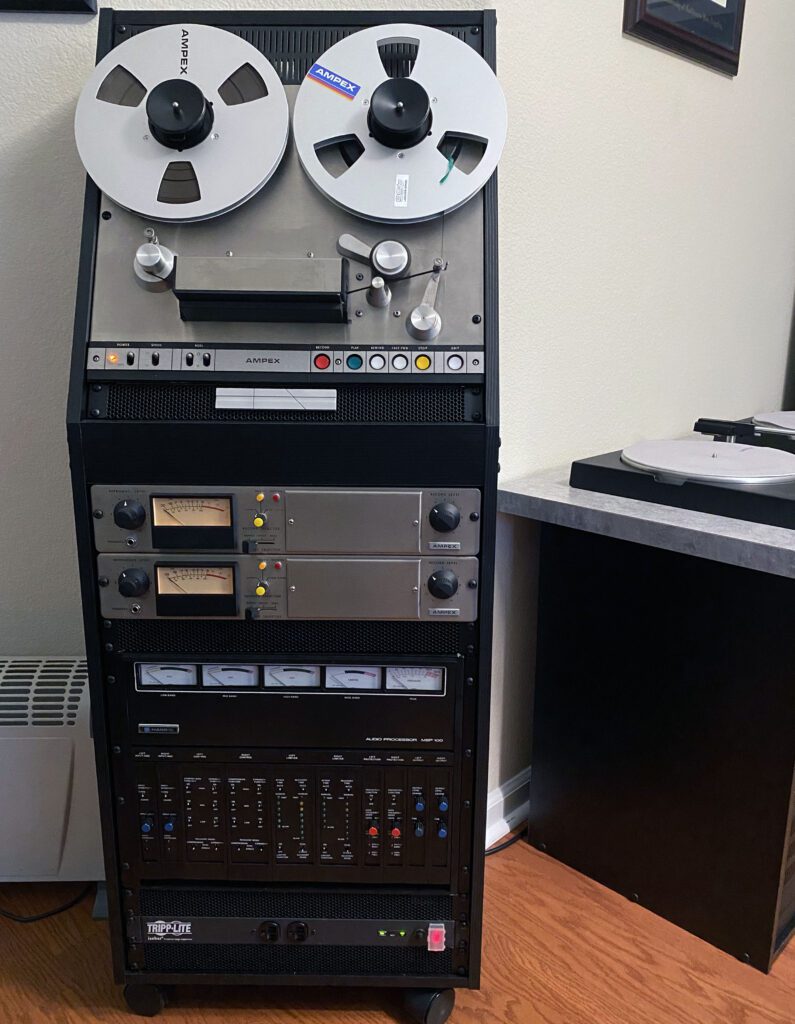
The full compliment of transmission gear is as follows:
- LINKCOMM 24-bay shielded RJ45 patch panel for telco interface
- Gates FM limiter (2 units)
- Moseley SCG-3 stereo generator
- Moseley SCG-8 SCA generator
- Moseley PCL-505 STL transmitter, 455 MHz band
- Moseley PCL-505 STL transmitter, 950 MHz band
- Moseley PCL-505 STL receiver, 450 MHz band
- Moseley PCL-505 STL receiver, 950 MHz band
- Rockwell/Collins 310Z-2 FM exciter with 786V-1 stereo generator card
- TFT 763 FM modulation monitor with TFT 764 FM preselector
- TFT 7601-R transmitter remote control
- ADC 96 point TT patch bay
- Furman stereo audio amplifiers
- Marti RPT-15 remote broadcast transmitter, 450 MHz band
- Marti CR-10 remote broadcast receiver, 450 MHz band
- Shure M-67 four-channel remote mixer
- Electro-Voice 635A interview microphone
- Shure SM58 interview microphone
- On-Air warning light
For additional detail, see the overall line drawing of the studio and the overall line drawing of the transmission system.
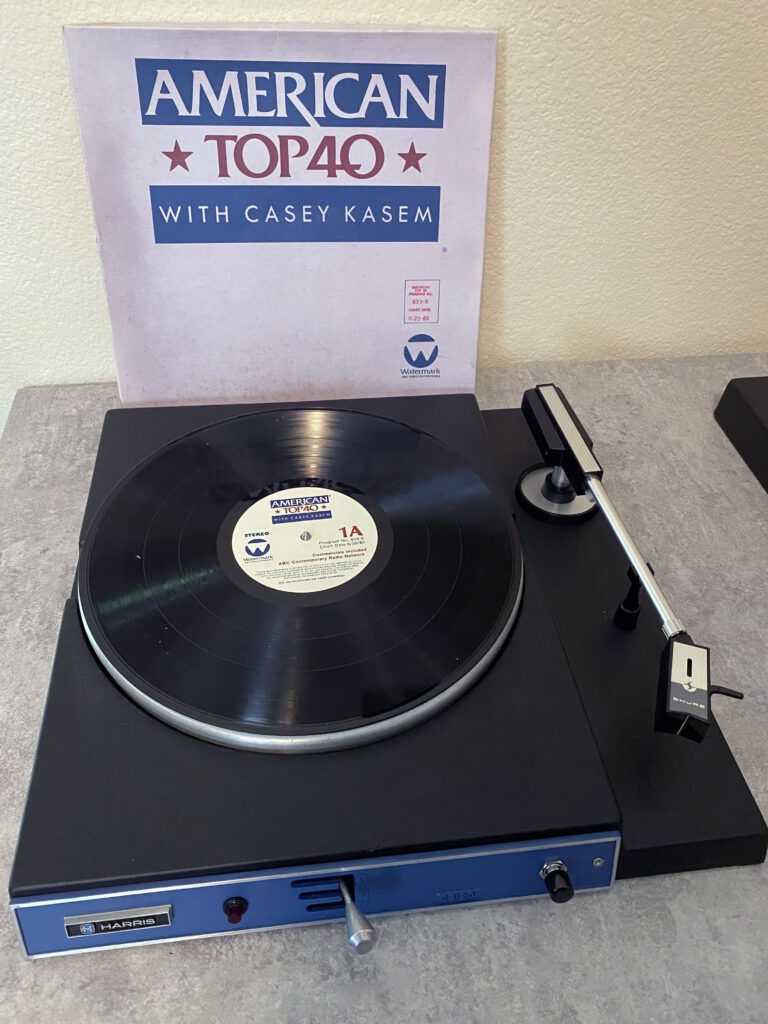
To round-out the vintage studio it seemed appropriate (and even necessary) to add some vintage vinyl. The current record library numbers about 250 albums, mostly 1960s and 70s rock, with some country included. A random search on eBay yielded the American Top 40 box set that aired on October 20, 1983. The four-record package includes the rundown sheet, which lists that week's "Hits From Coast to Coast." While a few years outside of the "70s era," it is nonetheless a cool piece of radio history.
Another piece of radio history that I was pleased to find on eBay was a 5-record set of the Drake-Chenault History of Rock and Roll series that aired in the early 1980s. Cool stuff. I remember listening to the series when I was (much) younger.
Most of the albums in my slowly-growing collection were purchased from used record stores. Fortunately, there are several stores in the San Francisco Bay Area (where I live) with a wide selection of artists. Most are in good shape overall, some in very good condition. I have also purchased new pressings that are re-releases of classic albums on 180 gram "ultra-analog" discs. They sound spectacular.
In a bit of irony, most of the records that I have collected so far are albums that I owned back in the day. In fact, there are some that I have purchased four times: first as an LP in the 1960s, second as a CD in the 80s, third as an MP3 in the 2000s, and fourth, now, as an LP (again). Like many baby boomers, I let my LP collection go away when CDs came out. That was a bad call. I have resolved to not buy the same album a fifth time!
The revival of interest in vinyl records is most encouraging. Some artists are releasing new albums on vinyl as well as downloadable files. The Vinyl Snob website has an interesting podcast on "Record Store Day" that is worth a listen.
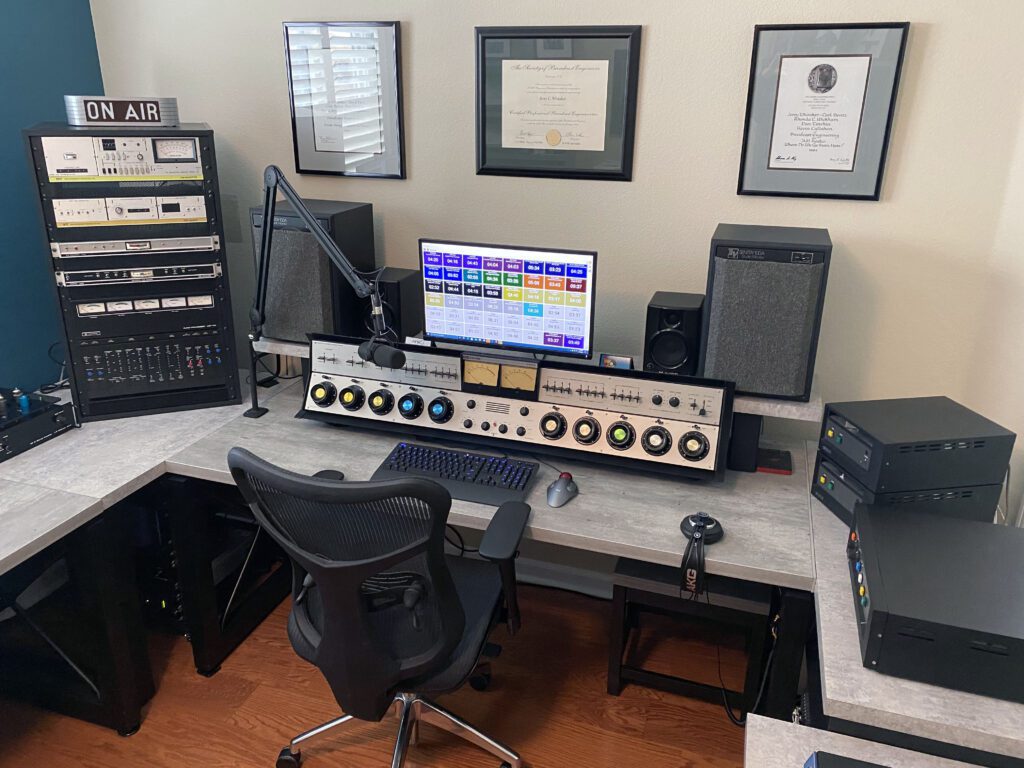
All of the hardware in the studio works and with the Collins exciter operating into a dummy load, the modulation monitors pick up enough energy to operate from an off-air sample. So, it is a complete FM radio station from microphone to transmitter (albeit a very low power station).
Through web searches and other means, I have been able to collect printed manuals for all equipment in the studio. Documentation, of course, is essential for proper operation and maintenance. If you are having trouble locating a manual for the equipment listed above, let me know. I may be able to help.
While the 1970s studio project has been officially completed, I continue to look for ways to improve and expand the studio. A recent addition was the Ampex AG-440 reel-to-reel recorder. It was a big project as the unit purchased on eBay was in rough condition. The restoration project is documented in a blog posting on this site. Other restoration projects are documented in the blog Additional Rebuild Projects for the 1970s Radio Studio.
In the process of building the 70s radio studio, I have developed documentation and other resources that may be of interest. Check out the Available Downloads blog posting for details.
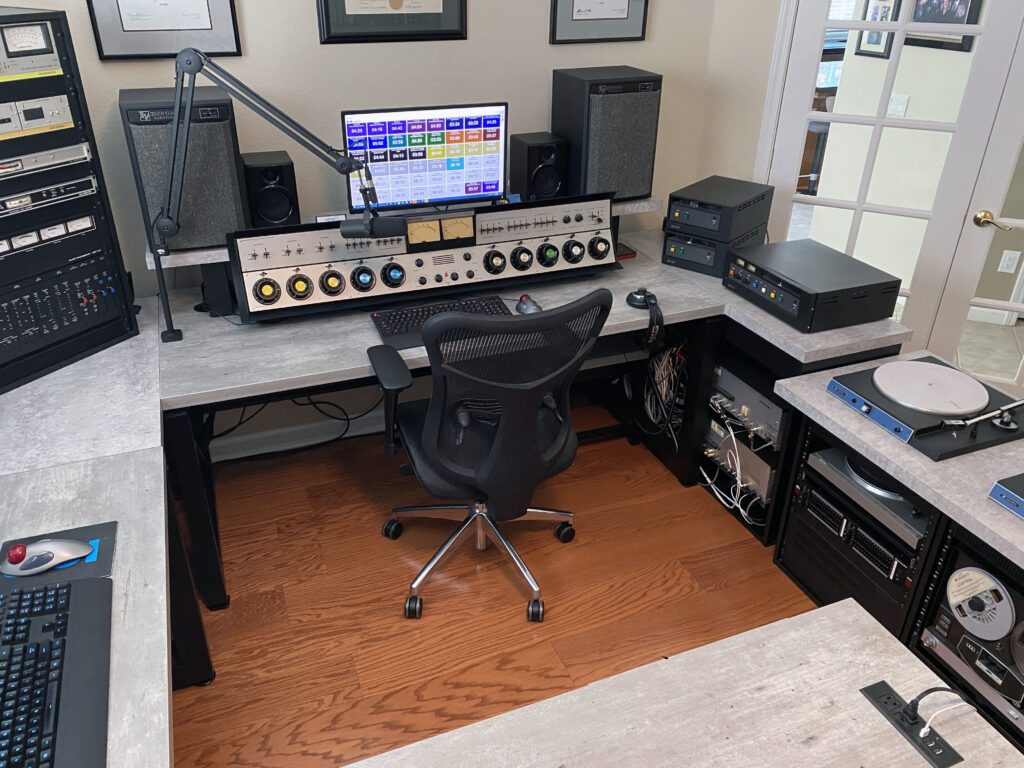
Having completed the 1970s radio studio, the focus shifted to the building (refurbishing) a 1970s-era radio automation system. That project is chronicled in the Radio Studio Automation System blog.
Looking further down the road, I have collected enough hardware to build a 1970s-era radio production studio. That project is just beginning, as documented in the 1970s Era Radio Production Room blog.
For several years I have been looking for an FM transmitter to round-out the 70s radio studio collection. I would love to find a Rockwell Collins 831G-1; that's the type I put on the air in 1979. A photo of me and the transmitter is shown below.
There are several problems with collecting this transmitter, however. First, it is big and heavy. Second, it requires an ac power service of 208 V 3-phase 4-wire-wye. Third, while I have found such transmitters on eBay, shipping is a major challenge. I had a line on a smaller 2.5 kW Collins rig, but somebody bought it while I figured out how to ship the thing. I haven't given up.
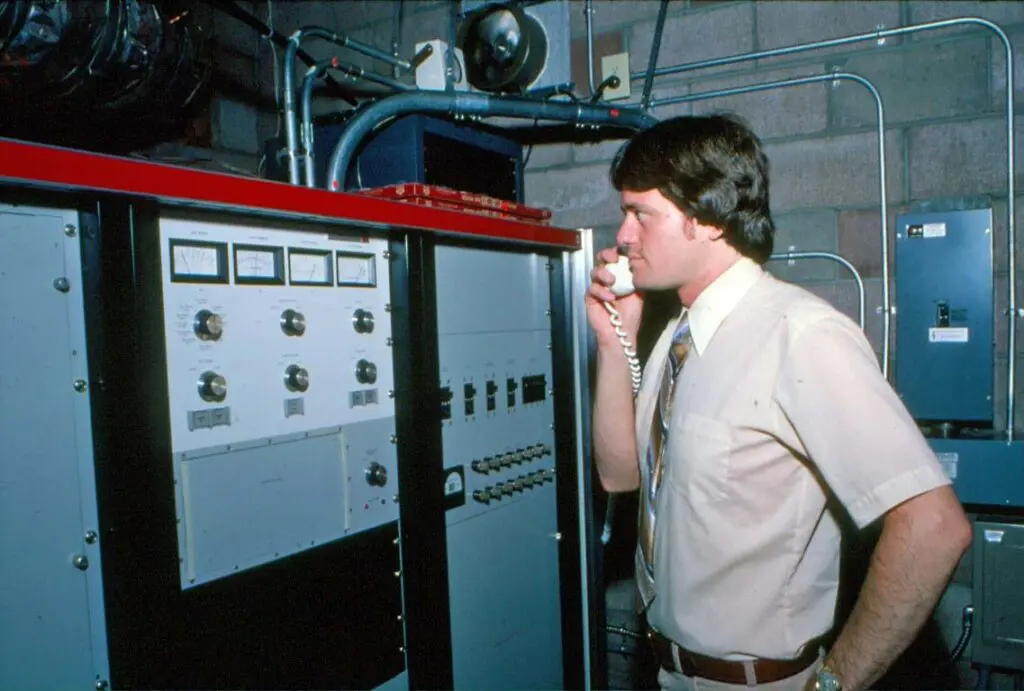
I have been asked (by family members) what's the end game for the 1970s radio studio? I haven't thought that far ahead, and besides I'm having too much fun with the ongoing projects. In any event, I see two options at some point in the future: 1) sell it to a collector, or 2) donate the whole thing to a museum. Probably that. (Any interested museums out there? We should talk.)
Stay tuned...